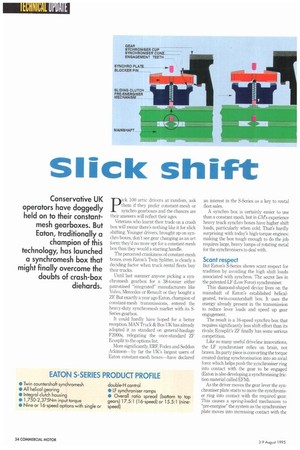Slick shift
Page 46

Page 47

If you've noticed an error in this article please click here to report it so we can fix it.
Conservative UK operators have doggedly held on to their constantmesh gearboxes. But Eaton, traditionally a champion of this technology, has launched a synchromesh box that might finally overcome the doubts of crash-box diehards.
pick 100 artic drivers at random, ask them if they prefer constant-mesh or synchro gearboxes and the chances are their answers will reflect their ages.
Veterans who learnt their trade on a crash box will swear there's nothing like it for slick shifting. Younger drivers, brought up on synchro boxes, don't see gear changing as an art form: they'd no more opt for a constant-mesh box than they would a starting handle.
The perceived crankiness of constant-mesh boxes, even Eaton's Twin Splitter, is clearly a deciding factor when truck rental fleets buy their trucks Until last summer anyone picking a synchromesh gearbox for a 38-tonner either patronised "integrated" manufacturers like Volvo, Mercedes or Renault or they bought a ZF. But exactly a year ago Eaton, champion of constant-mesh transmissions, entered the heavy-duty synchromesh market with its 5Series gearbox.
It could hardly have hoped for a better reception. MAN Truck & Bus UK has already adopted it as standard on general-haulage F2000s, relegating the once-standard ZF Ecosplit to the options list.
More significantly, ERF, Foden and Seddon Atkinson—by far the UK's largest users of Eaton constant-mesh boxes—have declared an interest in the S-Series as a key to rental fleet sales.
A synchro box is certainly easier to use than a constant mesh, but in CM experience heavy truck synchro boxes have higher shift loads, particularly when cold. That's hardly surprising with today's high-torque engines: making the box tough enough to do the job requires large, heavy lumps of rotating metal for the synchronisers to deal with.
Scant respect
But Eaton's S-Series shows scant respect for tradition by avoiding the high shift loads associated with synchms. The secret lies in the patented LF (Low Force) synchroniser.
This diamond-shaped device lives on the mainshaft of Eaton's established helicalgeared, twin-countershaft box. It uses the energy already present in the transmission to reduce lever loads and speed up gear engagement.
The result is a 16-speed synchro box that requires significantly less shift effort than its rivals; Ecosplit's ZF finally has some serious competition.
Like so many useful driveline innovations, the LF synchroniser relies on brain, not brawn. Its party piece is converting the torque created during synchronisation into an axial force which helps push the synchroniser ring into contact with the gear to be engaged (Eaton is also developing a synchronising friction material called EFM).
As the driver moves the gear lever the synchroniser plate starts to move the synchroniser ring into contact with the required gear. This causes a spring-loaded mechanism to "pre-energise" the system as the synchroniser plate moves into increasing contact with the LF ramps on the mainshaft spline.
These ramps convert the rotational movement of the synchroniser ring into an axial force which has two effects. First, it speeds up gear engagement, reducing the time needed to synchronise the rotation of the synchroniser ring and the new gear. Second, it reduces the effort needed to move the gearstick when changing gear.
Noise levels
Truck driveline noise levels are coming under ever-increasing scrutiny from environmental legislators but the S-Series' use of helical gearing has avoided the need for encapsulation or shielding. The aluminium-cased S-Series also looks very clean thanks to its integrated air system/shift control assembly (truck manufacturers can choose between a single or double H-shift pattern).
It's no surprise that MAN should be so enthusiastic about the S-Series—it was closely involved with development of the transmission, which underwent pre-production testing in the F2000. ZF clearly needs to match the S. Series' reduced shift loads if it is to get back in with MAN as first-choice synchro supplier in the UK.
It may pin its hopes on the automated AS Tronic (CM 3-9 November 1994), which is a twin-shaft, constant-mesh box using electronics to control the mechanical synchronisation. Ironically that would leave ZF switching from synchro to constant-mesh technology to continue its contest with Eaton, which has just moved in the opposite direction. That should give the pro and anti-synchro pundits down at the truckstop something to chew on.
E. by Brian Weatherley
































































































